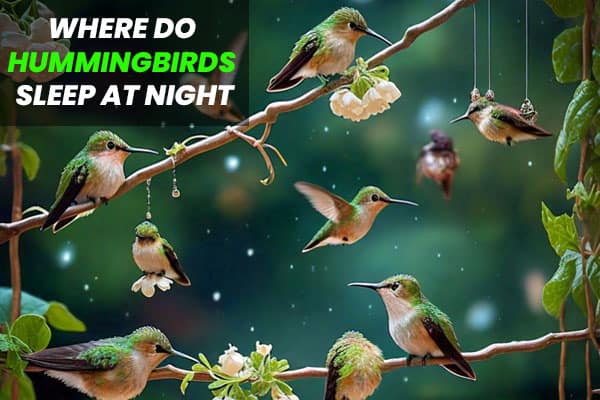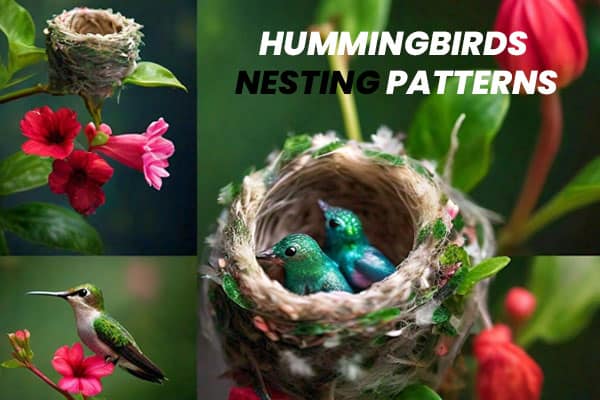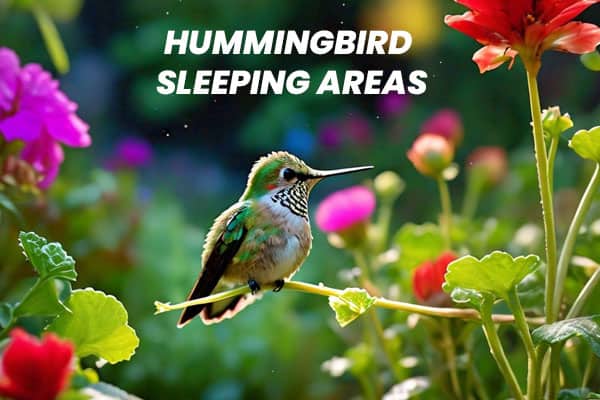Where Do Hummingbirds Sleep at Night? Unlocking Mystery
What you think Where Do Hummingbirds Sleep at Night? Hummingbirds are indeed fascinating creatures, and their sleeping habits are quite unique. When night falls, these tiny birds don’t disappear; they have special ways to rest. Hummingbirds usually sleep by hanging upside down on a branch, surrounded by dense vegetation to protect themselves from the cold, wind, and rain.
To save energy and stay warm enough to survive the night, hummingbirds enter a state called torpor. This is like a deep sleep where their metabolism slows down a lot, which helps them maintain just enough body heat. They can’t see well in the dark, so they sleep at night when there’s not enough light to feed. Waking up from torpor can take a while, sometimes up to an hour, as they need to shiver to generate body heat.
Hummingbirds generally sleep alone, perched on a branch where they’re safe from predators and harsh weather. They grip the branch tightly with their feet and point their beak upwards as they settle in for the night. It’s a remarkable adaptation that allows these energetic birds to survive and thrive.
Understanding the Nocturnal Habits of Hummingbirds
Hummingbirds, with their vibrant colors and delicate wings, are not just a sight to behold during the day. These tiny creatures have fascinating nocturnal habits that continue to captivate bird enthusiasts. In this section, we will delve into the hidden world of hummingbirds at night, shedding light on their nesting patterns and the sleeping areas they choose to rest in.
Hummingbird nesting patterns
Before we can understand their sleeping habits, it is important to explore the nesting patterns of hummingbirds. These birds have a knack for building intricate and well-hidden nests. The female hummingbird takes the lead in constructing the nest, which is usually camouflaged among the branches of trees or shrubs. The nests are built using a combination of soft materials like moss, spider silk, and plant fibers, providing a cozy space for the bird and its future offspring.
Hummingbird sleeping areas
When it comes to choosing a sleeping area, hummingbirds exhibit interesting preferences. They venture away from their nests and opt for safe and sheltered spots, ensuring protection from predators and the elements. These areas can vary and include tree branches, dense foliage, or even tall grass. The hummingbird’s small size allows it to find comfort in secluded and secure spots, where it can rest undisturbed throughout the night.
Understanding these nocturnal habits provides valuable insight into the behavior and lifestyle of hummingbirds. By gaining knowledge about their nesting patterns and sleeping areas, we can appreciate the unique challenges they face and the adaptations they have made to ensure their survival.
Notable Fact: The outstanding agility of hummingbirds allows them to perch upside down while sleeping, a behavior not commonly observed in other bird species.
In the next section, we will explore the preferred sleeping locations of hummingbirds in more detail. By learning more about these hummingbird sleeping sanctuaries and the importance of protecting them, we can contribute to the conservation efforts of these enchanting creatures.
| Hummingbird Nesting Patterns | Hummingbird Sleeping Areas |
|---|---|
| Camouflaged nests built using soft materials like moss, spider silk, and plant fibers. | Safe and sheltered spots such as tree branches, dense foliage, and tall grass. |
| Hidden among the branches of trees or shrubs. | Provide protection from predators and the elements. |
| Constructed primarily by the female hummingbird. | Secured, secluded areas where hummingbirds can rest undisturbed. |
Preferred Sleeping Locations of Hummingbirds
Where Do Hummingbirds Sleep at Night: In their quest for a peaceful and safe slumber, hummingbirds have specific preferences when it comes to their sleeping locations. These tiny creatures seek out hummingbird sleeping sanctuaries that provide the ideal conditions for their restful nights.
Hummingbirds are known to choose habitats and environments that offer protection from predators and the elements. One of their preferred sleeping locations is dense foliage, such as the canopies of trees or shrubs. These areas provide shelter from potential threats and also offer a snug spot where they can perch and relax.

Another favored sleeping location for hummingbirds is within the cover of vines or thick vegetation. These dense areas provide them with a sense of security and privacy during their slumber. The presence of leaves and branches not only shields them from predators but also acts as a natural barrier against harsh weather conditions.
Hummingbirds are also known to seek out the protection of small cavities, such as tree hollows or the insides of plants. These cozy spots offer an extra layer of security, as they are harder for predators to access. The hidden nature of these sleeping locations allows hummingbirds to rest undisturbed throughout the night.
To ensure the well-being of these enchanting creatures, it is crucial to focus on protecting hummingbird sleeping areas. By preserving their preferred habitats and creating designated sanctuaries, we can contribute to the conservation of hummingbird populations and their unique sleeping behavior.
Why Protecting Hummingbird Sleeping Areas is Important
Hummingbird sleeping sanctuaries play a vital role in the overall health and survival of these remarkable birds. By safeguarding their preferred sleeping locations, we can help mitigate the impact of habitat loss and fragmentation, which are major threats to their populations.
By protecting hummingbird sleeping areas, we are not only ensuring their safety and well-being but also maintaining the delicate balance of ecosystems they contribute to. It is our responsibility to be stewards of these fascinating creatures and preserve their unique sleeping behavior for generations to come.
In this table, we will explore examples of different hummingbird sleeping locations and their distinctive features:
| Sleeping Location | Features |
|---|---|
| Dense Foliage | Provides shelter from predators and harsh weather conditions. Offers a cozy perch for resting. |
| Vines and Thick Vegetation | Offers security, privacy, and protection from predators. Acts as a natural barrier against the elements. |
| Tree Hollows and Plant Cavities | Provides hidden and inaccessible sleeping spots, reducing the risk of disturbance from predators. |
Nesting Patterns and Sleeping Together
Hummingbirds are known for their unique nesting behavior, and it’s fascinating to explore how it relates to their sleeping habits. Do these tiny birds sleep alone, or do they have a tendency to sleep together? Let’s delve into this aspect of their social behavior and sleep dynamics to gain a deeper understanding.
Sleeping Solo or in Company?
When it comes to sleeping, hummingbirds exhibit diverse patterns. While some species prefer to sleep alone, others have a propensity for communal slumber. The choice of sleeping arrangements can depend on various factors, including their geographical location, available resources, and social dynamics.

In species that sleep alone, each bird typically has its own preferred sleeping spot. They meticulously select a secure location, such as a branch or the underside of a leaf, where they can rest undisturbed. This behavior helps reduce the risk of predation and allows them to conserve energy for the demanding activities of the following day.
On the other hand, certain hummingbird species have been observed forming communal roosting groups during the night. These groups can consist of a few birds or even several dozen individuals huddled together for warmth and protection. Such behavior is particularly common during colder seasons or in regions where resources are limited.
While the exact reasons for this communal sleeping behavior are not fully understood, it is believed to have evolutionary advantages. Sharing body warmth helps these birds regulate their body temperature more effectively, especially in cooler climates. Additionally, by sleeping together, they can benefit from safety in numbers, deterring potential predators and alerting each other in case of danger.
Hummingbirds exhibit diverse nesting patterns and sleeping habits. While some species prefer to sleep alone for safety and energy conservation, others engage in communal roosting for warmth and protection. These social behaviors provide unique insights into the intriguing world of hummingbirds.
Unveiling the Mystery of Hummingbird Sleeping Areas
Throughout this article, we have explored the captivating world of hummingbirds and unraveled the secrets behind their nighttime habits. Now, it’s time to unveil the mystery of where these tiny birds choose to rest during their slumber. The unique sleeping behavior of hummingbirds is truly fascinating and offers valuable insights into their survival strategies.

As we have discovered, hummingbirds have specific preferences when it comes to their sleeping areas. They seek out secluded and protected spots, such as dense foliage, shrubs, and trees, where they can find safety from predators and the elements. These sanctuaries provide them with the peace and security they need to recharge their energy for the day ahead.
Their sleeping behavior is as individual as their vibrant feathers. Some hummingbirds prefer to sleep alone, while others form small groups and sleep together. This social behavior allows them to benefit from safety in numbers, increasing their chances of detecting and evading potential threats. It also provides them with a sense of companionship during their vulnerable resting hours.
Now, armed with this knowledge about hummingbird sleeping behavior and the unique sleeping areas they choose, you have gained a deeper appreciation for these remarkable creatures. The world of hummingbirds is filled with wonders, and their sleeping habits only add to the magic of these tiny avian marvels.
Check Our Previous Articles
| Black Bird With Yellow Beak |
| What Time Do Birds Wake Up? |
| Hawks You Can See in Tennessee |
| Blackbirds (Icteridae) |
Frequently Asked Questions About Where Do Hummingbirds Sleep at Night
Q1: Do hummingbirds sleep at night time?
Yes, hummingbirds do sleep at night, typically perching on branches or other safe spots to rest.
Q2: What is the body temperature of a hummingbird?
The body temperature of a hummingbird ranges from around 105 to 108 degrees Fahrenheit (40 to 42 degrees Celsius), which is higher than most birds.
Q3: What does it mean when you are visited by a hummingbird?
Being visited by a hummingbird is often seen as a symbol of joy, love, and happiness in many cultures. It can also be a sign of resilience and adaptability.
Q4: How does a hummingbird tongue work?
A hummingbird’s tongue works like a tiny pump. When it extends into a flower, it opens and the tip forks out. As the bird retracts its tongue, it closes, creating a vacuum that draws nectar into its mouth.






